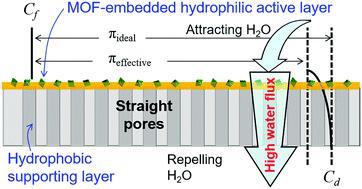当前位置:
X-MOL 学术
›
Environ. Sci.: Water Res. Technol.
›
论文详情
Our official English website, www.x-mol.net, welcomes your
feedback! (Note: you will need to create a separate account there.)
Enhancing water permeability with super-hydrophilic metal–organic frameworks and hydrophobic straight pores
Environmental Science: Water Research & Technology ( IF 3.5 ) Pub Date : 2021-4-14 , DOI: 10.1039/d1ew00036e Mehdi Habibollahzadeh 1 , Juran Noh 1 , Liang Feng 2 , Hong-Cai Zhou 2 , Ahmed Abdel-Wahab 3 , Choongho Yu 1, 4
Environmental Science: Water Research & Technology ( IF 3.5 ) Pub Date : 2021-4-14 , DOI: 10.1039/d1ew00036e Mehdi Habibollahzadeh 1 , Juran Noh 1 , Liang Feng 2 , Hong-Cai Zhou 2 , Ahmed Abdel-Wahab 3 , Choongho Yu 1, 4
Affiliation

|
High water flux and salt selectivity have been the most demanding goals for osmosis-based membranes. Osmotic pressure differences across membranes are particularly important in emerging forward osmosis and pressure retarded osmosis applications, and they are strongly dependent on internal concentration polarization (ICP) and water permeability. Here, we have studied the influence of hydrophobic straight pores perpendicular to the membrane plane and super-hydrophilic metal–organic frameworks (MOFs) on membrane performance. We found that straightening the pores in the supporting layer significantly reduced flow resistance. While water can pass through the hydrophobic supporting layer with minimal interaction, the hydrophilic MOF in the active layer effectively attracts water to the membrane, synergistically augmenting water permeability without considerable reduction of salt rejection. The low tortuosity by straightening the pores in the supporting layer clearly shows the benefit of increasing water permeability compared with a membrane whose pores are more tortuous. We also corroborated the effectiveness of MOF inclusion by varying its concentration, showing outstanding performance in water permeability compared with those of conventional and advanced thin-film composite membranes with high salt selectivity. This work presents a promising membrane configuration for further improving osmotic pressure by increasing the water flux.
中文翻译:

超亲水金属有机骨架和疏水性直孔增强了水的渗透性
对于基于渗透的膜,高水通量和盐选择性一直是最苛刻的目标。在新兴的正向渗透和压力延迟渗透应用中,跨膜的渗透压差特别重要,并且它们强烈依赖于内部浓度极化(ICP)和水渗透性。在这里,我们研究了垂直于膜平面的疏水性直孔和超亲水金属有机骨架(MOF)对膜性能的影响。我们发现,拉直支撑层中的孔会大大降低流动阻力。尽管水可以最小的相互作用穿过疏水性支撑层,但活性层中的亲水性MOF却有效地将水吸引到了膜上,协同增强水的渗透性,而不会显着降低除盐率。通过使支撑层中的孔变直而具有较低的曲折度,与孔较曲折的膜相比,显然显示出增加水渗透性的益处。我们还通过改变其浓度来证实MOF夹杂物的有效性,与具有高盐选择性的传统和先进薄膜复合膜相比,它在水渗透性方面表现出出色的性能。这项工作提出了一种有前途的膜结构,可通过增加水通量来进一步提高渗透压。通过使支撑层中的孔变直而具有较低的曲折度,与孔较曲折的膜相比,显然显示出增加水渗透性的益处。我们还通过改变其浓度来证实MOF夹杂物的有效性,与具有高盐选择性的传统和先进薄膜复合膜相比,它在水渗透性方面表现出出色的性能。这项工作提出了一种有前途的膜结构,可通过增加水通量来进一步提高渗透压。通过使支撑层中的孔变直而具有较低的曲折度,与孔较曲折的膜相比,显然显示出增加水渗透性的益处。我们还通过改变其浓度来证实MOF夹杂物的有效性,与具有高盐选择性的传统和先进薄膜复合膜相比,它在水渗透性方面表现出出色的性能。这项工作提出了一种有前途的膜结构,可通过增加水通量来进一步提高渗透压。
更新日期:2021-05-07
中文翻译:

超亲水金属有机骨架和疏水性直孔增强了水的渗透性
对于基于渗透的膜,高水通量和盐选择性一直是最苛刻的目标。在新兴的正向渗透和压力延迟渗透应用中,跨膜的渗透压差特别重要,并且它们强烈依赖于内部浓度极化(ICP)和水渗透性。在这里,我们研究了垂直于膜平面的疏水性直孔和超亲水金属有机骨架(MOF)对膜性能的影响。我们发现,拉直支撑层中的孔会大大降低流动阻力。尽管水可以最小的相互作用穿过疏水性支撑层,但活性层中的亲水性MOF却有效地将水吸引到了膜上,协同增强水的渗透性,而不会显着降低除盐率。通过使支撑层中的孔变直而具有较低的曲折度,与孔较曲折的膜相比,显然显示出增加水渗透性的益处。我们还通过改变其浓度来证实MOF夹杂物的有效性,与具有高盐选择性的传统和先进薄膜复合膜相比,它在水渗透性方面表现出出色的性能。这项工作提出了一种有前途的膜结构,可通过增加水通量来进一步提高渗透压。通过使支撑层中的孔变直而具有较低的曲折度,与孔较曲折的膜相比,显然显示出增加水渗透性的益处。我们还通过改变其浓度来证实MOF夹杂物的有效性,与具有高盐选择性的传统和先进薄膜复合膜相比,它在水渗透性方面表现出出色的性能。这项工作提出了一种有前途的膜结构,可通过增加水通量来进一步提高渗透压。通过使支撑层中的孔变直而具有较低的曲折度,与孔较曲折的膜相比,显然显示出增加水渗透性的益处。我们还通过改变其浓度来证实MOF夹杂物的有效性,与具有高盐选择性的传统和先进薄膜复合膜相比,它在水渗透性方面表现出出色的性能。这项工作提出了一种有前途的膜结构,可通过增加水通量来进一步提高渗透压。









































 京公网安备 11010802027423号
京公网安备 11010802027423号